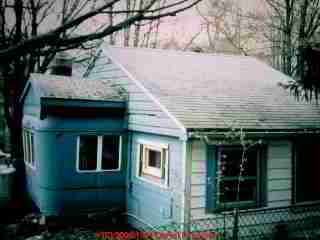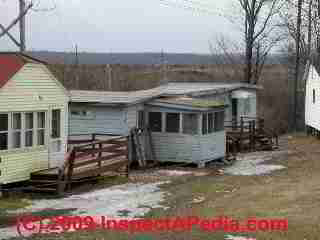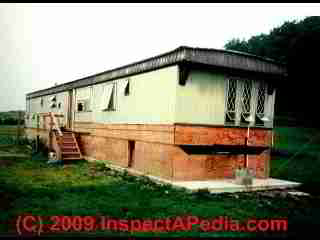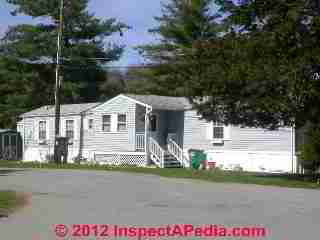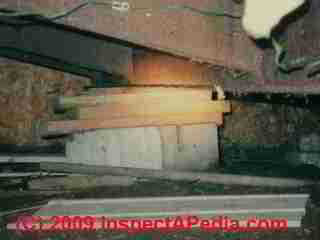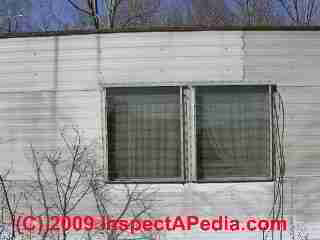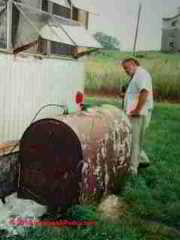 How to Inspect & Troubleshoot Mobile Homes,
How to Inspect & Troubleshoot Mobile Homes,
Double wides, Caravans, Manufactured Homes, & Trailers
Home Page & Index to Articles
- POST a QUESTION or COMMENT about inspection of the condition of manufactured homes, mobile homes, mobile home, caravan, static caravan or trailer or doublewide problem diagnosis procedures, & their care, repair, & maintenance
How to Inspect Double-Wides, Mobile Homes, Trailers or Manufactured Housing for Defects:
Included in this article series are detailed inspection procedures, defect lists, codes. We explain where to look for costly or dangerous problems on manufactured homes or mobile homes, trailers, or double-wides.
We include lists of defects found on manufactured or mobile homes, trailers, double-wides, caravans, static caravans. You also will find a guide to safety codes for manufactured / mobile homes: the federal and other building codes regulate manufactured homes, mobile homes & doublewide homes. Wind & tie-down regulations for mobile homes & double-wides are included.
We address all of the major parts and systems of manufactured or mobile home structures and suggest field inspection procedures as well as common hidden problem and common repair procedures. This article series includes copies of manufactured home & mobile home codes & standards as free down-loadable PDFs.
InspectAPedia tolerates no conflicts of interest. We have no relationship with advertisers, products, or services discussed at this website.
- Daniel Friedman, Publisher/Editor/Author - See WHO ARE WE?
Inspection & Repair of Manufactured Homes, Doublewides, Caravans & Mobile Homes
Article Contents
- MOBILE HOMES, DOUBLEWIDES, TRAILERS - home Ver.17 , updated through 2023 - Steve Vermilye, New Paltz NY and Daniel Friedman, Poughkeepsie NY, Hudson Valley ASHI Chapter Seminar, Newburgh NY, January 4, 2000, NY Metro ASHI Fall 99 Seminar, Holiday Inn Crowne Plaza, White Plains NY, October 2, 1999.
With deep sorrow we report that our friend and associate, Steven T. Vermilye of New Paltz NY (photo at the top of this page) passed away on 19 June 2001, so of course you will have difficulty contacting him by normal means.
Steve was a leader in the home inspection profession, recognized nationally as well as among New York State professional home inspectors for his competence, kindness, honesty, humility, humor, and for his unequivocal commitment to the welfare of his clients.
Steve led our interest in mobile home inspections by offering us an opportunity to join with him to work pro-bono in behalf of agricultural workers in the Hudson Valley -- a service which we continue in his memory.
Definitions of Mobile Home, Trailer, Doublewide, Modular Home, Factory-Built Home, Panelized-Construction-Built Home?
The following is the opinion of the author and has not had a technical review by other industry experts. Various trailer, mobile home, and modular housing manufacturers may disagree with some of these views. Corrections and content suggestions are welcome.
Characteristics of Trailers as Living Space
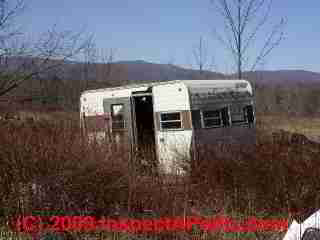 Trailer traditionally describes a usually small, wheeled, home with a history and image of flimsy construction
such as wooden 1x3 wall framing clad with aluminum siding, virtually no insulation, and low quality leaky windows.
Trailer traditionally describes a usually small, wheeled, home with a history and image of flimsy construction
such as wooden 1x3 wall framing clad with aluminum siding, virtually no insulation, and low quality leaky windows.
"Trailers" up until the 1970's (my estimate) included both campers which really were intended to be towed by a car or truck and moved often from site to site (though some were left parked for decades at campgrounds), and also lightweight factory-made homes which were intended to be towed once to a home site and then kept there.
Our photo (above) shows a trailer that was finally abandoned as a living space. The little blue structure used as an addition to the left of the small house in the photo at the top of this page was undoubtedly a small camper.
No one building "trailers" calls them that any longer because of the "flimsy" image. The closest thing to a "trailer" in current products on the market are motor homes and campers.
The least-costly campers (such as our pickup truck "slide-on camper") built after 2000 are probably considerably better constructed than the "trailers" of old.
In current language (2009), a "trailer" is either a "mobile home" that is more than 20 years old (see below), or it is a camper designed to be moved easily and often from site to site.
(Or in different usage, a "utility trailer" is a utility vehicle intended to haul goods or large items and designed to be fastened to the back of a car or truck, and a "tractor trailer" is of course a larger (typically 40 ft long) hauling system for moving goods by highway from city to city.)
Trailers may have had their wheels left on, but normally they'd be set on a masonry pier foundation and a skirt installed around to hide the under-trailer area.
Characteristics of Mobile Homes as Living Space
In the past few decades (to 2014), "trailer" manufacturers have considerably improved the quality of construction of such homes. The national manufacturing and building code standards for these structures have also been improved.
Perhaps in part to escape the less than wholesome image of "trailer", manufacturers use the term "mobile home" to describe what is usually larger and better made home than "trailers" of old, though perhaps with similar materials.
Mobile homes are built in a factory and are designed to be moved (once and uncommonly, perhaps once again) on its own wheels attached to its own frame to a site where a foundation is prepared and connections to utilities are made. In the U.S., states have regulations about the siting, foundation, steps and entry, wiring, plumbing, tie-downs for wind and storm safety that apply to these homes.
Some examples of mobile home regulations for New York State are this website. Individual state regulations will vary - you'll want to see what your state requires. Even within states regulations vary as wind and weather conditions do also.
Examples of mobile home improvements include stronger overall wall and roof construction, less leaky roof covering, and windows that are less notoriously leaky. In addition newer mobile homes have, for fire safety, bedroom windows that can be pushed out to a wide opening for emergency exit in case of fire - an important safety improvement.
Usually building departments grandfather in older structures, but sometimes they will insist that certain life-safety improvements be made, for example if an older mobile home is being brought to a new site in a new community. If this is the case one or two windows may need to be replaced to provide this important safety improvement.
When there is a severe storm or hurricane, mobile home communities are among the worst damaged as a strong wind can completely turn over or demolish mobile homes. For this reason, mobile homes set up in high wind-risk zones have extra requirements for tie-downs to secure the building against upset during a storm.
Mobile homes may arrive on wheels but they will be jacked enough to be set on some type of approved building foundation, such as masonry piers or a masonry foundation.
In case these terms are not confusing enough, some mobile home makers like to call these "factory built homes". But that use of "factory-built homes" is confusing too since modular homes are also "factory built" but are quite different from trailers or mobile homes.
Characteristics of a "Doublewide" Mobile Home or Trailer
Some manufacturers provide mobile homes constructed to be joined together, side by side to form a double-width living unit. While a double-wide mobile home is basically constructed by the same materials and methods just described above, the tie-down and connection requirements for these living units may be different in some jurisdictions, since their risk of being blown away in high winds is different.
Other installation and support requirements, such as connection of the two units and placement of foundation support will also have to accommodate this variation.
Definitions: If you are not sure if your home is a mobile home, trailer, double-wide, caravan, or a modular or panelized-built or factory built home, please
see DEFINITIONS of Mobile Home, Doublewide, Modular, Panelized Construction
We found so many unsafe and un-healthy conditions in the trailers and mobile homes occupied by migrant farm workers that there was almost no safe habitable housing at the facility.
The facility owner, responding to suggestions from our report and from the N.Y. Office of the Attorney General and an attorney representing farm workers made extensive improvements in farm worker housing as a result of Steve's initiative.
Many of the photographs used to illustrate defects and needed repairs at these mobile homes, trailers, and double-wides came from Steve or from our own photos when we worked together.
We all miss Steve Vermilye and his passing remains a great loss. If the information in this report assists anyone in assuring that their home is more safe and secure than it would have been otherwise, that benefit is thanks to Steven Vermilye -- this information is one of his many gifts to the people for whom he cared deeply -- Daniel Friedman.
Consumer Reports (2/98) points out common weak spots surveyed and recommends that buyers hire a home inspector. But many inspectors are not familiar with the special problems found in mobile homes.
- Price: $15-$70K; 15 million in U.S.;
- "mobile homes" aka "manufactured housing" per the industry - confused with modulars & panelized.
- single mobile home vs. double-wide trailers (specs)
- single wide mobile homes
- typical 1000 sq ft, $24,000.,
- more problems with floors, roofs, windows, doors
- multi-wide mobile homes, double wide trailers, popout trailers and manufactured homes
- typical 1600 sq ft, $43,000.
- more problems with joining of the sections
- 1x lumber and siding "trailer" construction vs. more recent
- land often not-owned; rented 50% of the time
- 1974 HUD Code (Red seal certification label on newer units); inspections @ factory; HUD-complying homes do not have to comply with local Building codes! HUD regulations have loopholes and need work.
- 7 States: AZ, AR, CA, FL, TX, VA, W. Va. - have funds for warranty claims; NOT NYS.
- 82% of respondents reported overall satisfaction with M. H. (C. R. survey)
- But more than 50% report at least one major problem, even for homes less than 5 years old. (C. r. survey)
Definitions: What is a Mobile Home, Trailer, Camper, Doublewide mobile home, Modular Home, Factory-Built Home, Panelized-Construction-Built Home?
These terms are defined at TRAILER VS MOBILE HOME VS MODULAR VS PANELIZED CONSTRUCTION an explanation of terms and how to identify these structures.
Priorities of Inspection & Reporting of Manufactured Home / Mobile Home Defects
Bottom line: safety concerns are the first priority when inspecting any home or other building. The most common areas of safety worries for manufactured or mobile homes, discussed in more detail at references given below, include, in our OPINION, at least the following:
- Fire safety including working, safe fire exits
- Structural safety, including proper tie-downs in areas at risk of storm, hurricane, or tornado damage
- Electrical safety, such as DIY add-on and unsafe electrical wiring
- Health and sanitation, such as proper plumbing water supply and drainage, safe disposal of sewage or wastewater, and for homes that are leaky, mold contamination hazards
Mobile Home, Trailer Manufactured Home Safety & Structural Defects
Watch out: Safety for building occupants must be the first concern for anyone inspecting a manufactured home or mobile home.
See mobile home safety details
Mobile home or manufactured home structural defects are now detailed
at MOBILE HOME STRUCTURAL DEFECTS
Trailer or mobile home foundations and tie-downs are discussed in detail
at MOBILE HOME STABILIZING SYSTEMS
Mobile / Manufactured Home Fire Safety Inspection
See details and a detailed mobile home fire-safety inspection checklist
Other Common Mobile Home & Trailer Defects
- Roof leaks
- Leaks at windows and doors (photo at left)
- Plumbing leaks
- Heating systems not maintained, possibly unsafe
- Rot and insect damage at points of leakage into walls and floors
- Wet or contaminated crawl areas, especially where enclosed
Manufactured Home Labels & Mobile Home Labels & Manufactured Housing Labels & Certifications
This topic has moved to MOBILE / MANUFACTURED HOME LABELS
Mobile Home Leak & High Moisture Level Troubles
Moved to MOBILE / MANUFACTURED HOME LEAKS & MOISTURE
...
Reader Comments, Questions & Answers About The Article Above
Below you will find questions and answers previously posted on this page at its page bottom reader comment box.
Reader Q&A - also see RECOMMENDED ARTICLES & FAQs
On 2021-09-06 by inspectapedia.com.moderator (mod) - is the hazard of asbestos eliminated if the material is burned?
@mike smith,
Our conversation is now found
On 2021-09-06 by mike smith
i had a sample size piece of ceiling material i was told may be asbestos that was in a outbuilding that got burned up on my property. with being a small piece of material and a large fire,would the material if asbestos containing be denatured after being burned?
On 2021-07-24 by inspectapedia.com.moderator (mod) - effect of galvanized water pipes on water quality in a mobile home
@Martins,
Old galvanized iron pipe in buildings has as its principal artifact of condition clogging or reduced interior pipe diameter and therefore reduced flow rate because of a buildup of iron from rust and possibly mineral scale.
Therefore you wouldn't expect to have detectable levels of zinc in the water traced to that source.
Search this website using the on Page search box for
GALVANIZED IRON PIPE
to read details.
On 2021-07-23 by Martins
I am trying to find out what can be expected as far as water quality of
Galvanized iron pipes older than 40 years leading to individual homes rather small with at most an inch circumference .
I heard with aging zinc it’s properties can cause confusion , dizziness abd so on - what is your opinion ?
On 2021-07-18 by inspectapedia.com.moderator (mod) - horrible smell from squirrels in the roof of my manufactured home
@Patricia Chrisman,
Unfortunately the usual and most-direct repair is to remove the interior ceiling and insulation, clean and disinfect the exposed surfaces, then reinsulate and put up a new ceiling;
Doing that from above is usually more expensive and dramatic because you'd have to literally cut open or cut off the original metal roof of the mobile home - presuming that's what we are discussing (not a wood-framed modular home)
I would schedule all of that work with the same contractor if possible; there's no point in fixing the insulation in the roof cavity if the roof is leaky.
On 2021-07-18 by Patricia Chrisman
I have '91 manufactured home that I bought at a foreclosure sale. I discovered that red squirrels had been getting under the roof & could be heard above the exhaust fan in the bathroom.
They used the insulation for nest making in the soffit. 3 yrs ago the roof venting apparently went bad as hot humid air was blasting out behind the ceiling & wall trim.
A horrible odor which I assume is rodent urine started in my laundry room when the temp is hot & humid...it's so gross! I'm looking to have the roof replaced, but I believe that the problem is between the ceiling & roof.
That area of the house gets much hotter than the rest so obviously the insulation needs be replaced. How do go about resolving the odor & insulation problem before a new roof?
On 2020-06-23 - by (mod) - doublwide home sections not aligned
PJ
You may be seeing poor placement when the two halves of the home were set on the foundation, or the root problem could have been the foundation footprint itself.
Are there cracks, openings, leaks, signs of movement? Have you contacted the installer?
On 2020-06-23 by Pj Dukes
I bought a new double wide mobile home and where it was put together the space where the ceiling meets is a lot wider at one end than the other. Also the front half of the roof is longer on one end than the back half
On 2020-05-26 by (mod) - How far apart should floor boards be installed?
Anon
If by floorboards you are referring to the subfloor or finish flooring those boards are generally touching or quite close together. Subfloor plywood might be the thickness of a matchbook apart.
If you were asking about floor support framing which we would call floor joists those are typically 16in on Center.
On 2020-05-2 by Anonymous
How far apart should floor boards be installed?
On 2020-05-12 - by (mod) -
Barbara
In the ARTICLE INDEX please see MOBILE HOME EXTERIOR DEFECTS where we include exterior stair and entry hazards and requirements as well as giving you the links to codes.
On 2020-05-11 by Barbara Rainville
Where can we find HUD specifications for stair and decks for a new double-wide trailer?
On 2019-10-24 by (mod) - can I join up two singlewide mobile homes?
Unfortunately single wide mobile homes are not designed to be joined together. It's not that it's technically impossible it's that because you're doing something non-standard your local code officials are likely to be a little nervous. Can you afford to hire an engineer who can draw a plan for you, or an architect?
On 2019-10-23 by Julie - National manufactured housing construction and safety standards act of 1974
I have a single wide mobile home and want to join a second single wide home to it. I am recieving extreme resistance from the building department in my county in Michigan. Where can I find, if it exists, the Federal regulations for joining 2 single wide homes? I was directed to the National manufactured housing construction and safety standards act of 1974 (42 U.S C. Section 5401, et seq.), but I have no idea why.
First we were told we could not put a hole in the wall to join them "no physical alterations allowed to either home". So we line a window up to a door. The next thing was the snow load. We would put a free standing roof over both homes to bear these snow weight. I'm Notre sure what else to do.
Thanks
...
Continue reading at MOBILE HOME CODES, STANDARDS & MANUALS or select a topic from the closely-related articles below, or see the complete ARTICLE INDEX.
Or see MOBILE HOME, DOUBLEWIDE, TRAILER FAQs - questions & answers posted originally on this page
Or see these
Recommended Articles
- INSPECT ATTICS for MOISTURE or MOLD
- MOBILE HOMES, DOUBLEWIDES, TRAILERS - home
- DEFINE MOBILE HOME, DOUBLEWIDE, MODULAR, PANELIZED
- MANUFACTURED / MOBILE HOME DATA TAGS
- MOBILE HOME BUYERS ADVICE
- MOBILE HOME BUYERS GUIDE to SEPTIC SYSTEMS
- MOBILE HOME CODES, STANDARDS & MANUALS
- MOBILE HOME CONNECTIONS, MULTI-WIDE
- MOBILE HOME COOLING SYSTEMS
- MOBILE HOME CRAWL SPACES
- MOBILE HOME DEMOLITION / REMOVAL / RELOCATION
- MOBILE HOME ELECTRICAL SYSTEMS
- MOBILE HOME ELECTRICAL - FLICKERING LIGHTS
- MOBILE HOME ELECTRICAL GFCI DIAGNOSIS
- MOBILE HOME ELECTRICAL POWER LOST
- MOBILE HOME EXTERIOR DEFECTS
- MOBILE HOME HEATING SYSTEMS
- MOBILE HOME INSPECTIONS
- MOBILE HOME FIRE SAFETY
- MOBILE HOME INSULATION & VENTILATION
- MOBILE HOME SKIRTING
- MOBILE HOME SKIRTING CODES
- MOBILE HOME INTERIOR DEFECTS
- MOBILE / MANUFACTURED HOME LABELS
- MOBILE / MANUFACTURED HOME LEAKS & MOISTURE
- MOBILE HOME PLUMBING
- MOBILE HOME ROOF LEAKS, DEFECTS
- MOBILE HOME SAFETY DEFECTS
- MOBILE HOME STRUCTURAL DEFECTS
- MODULAR HOME CONSTRUCTION
Suggested citation for this web page
MOBILE HOMES, DOUBLEWIDES, TRAILERS at InspectApedia.com - online encyclopedia of building & environmental inspection, testing, diagnosis, repair, & problem prevention advice.
Or see this
INDEX to RELATED ARTICLES: ARTICLE INDEX to MANUFACTURED & MOBILE HOMES
Or use the SEARCH BOX found below to Ask a Question or Search InspectApedia
Ask a Question or Search InspectApedia
Try the search box just below, or if you prefer, post a question or comment in the Comments box below and we will respond promptly.
Search the InspectApedia website
Note: appearance of your Comment below may be delayed: if your comment contains an image, photograph, web link, or text that looks to the software as if it might be a web link, your posting will appear after it has been approved by a moderator. Apologies for the delay.
Only one image can be added per comment but you can post as many comments, and therefore images, as you like.
You will not receive a notification when a response to your question has been posted.
Please bookmark this page to make it easy for you to check back for our response.
IF above you see "Comment Form is loading comments..." then COMMENT BOX - countable.ca / bawkbox.com IS NOT WORKING.
In any case you are welcome to send an email directly to us at InspectApedia.com at editor@inspectApedia.com
We'll reply to you directly. Please help us help you by noting, in your email, the URL of the InspectApedia page where you wanted to comment.
Citations & References
In addition to any citations in the article above, a full list is available on request.
- [1] Section 184 Indian Home Loan Guarantee Program, U.S. Department of Housing & Urban Development, web search 1/5/2012, original source: portal.hud.gov/hudportal/HUD?src=/program_offices/public_indian_housing/ih/homeownership/184 - Quoting:
The Section 184 Indian Home Loan Guarantee Program is a home mortgage specifically designed for American Indian and Alaska Native families, Alaska Villages, Tribes, or Tribally Designated Housing Entities. Section 184 loans can be used, both on and off native lands, for new construction, rehabilitation, purchase of an existing home, or refinance.
Also see Freddie Mac & Fannie Mae - [2] Native American Housing Loan Guarantee Program HUD Section 184 Loans At A Glance, FannieMae, web search 1/5/12, original source: efanniemae.com/sf/mortgageproducts/pdf/section184aag.pdf
- [5] "Modular Home Construction, special defects and inspection methods" Dan Friedman, NY Metro ASHI Seminar, Holiday Inn, Crowne Plaza, White Plains NY, October 4, 1996
- [9] New York State: "Manufactured Homes: an installation guide for the code enforcement official," undated. [Div. of Code Enforcement & Admin. - 518-474-4073, George E. Clark, Jr., Director] - this is a guide tool, not an enforcement code or standard.
- [10] HUD State Administrative Agency (for 36 states) (NY: 518-474-4073) - for complaints
- [11] Manufactured Housing Institute, 2101 Wilson Blvd. Ste. 610, Arlington VA 22201 703-558-0400 Web: mfghome.org
- [12] NYMHA, 35 Commerce Ave., Albany NY 12206-2015 518-435-9859 800-721-HOME (they want the Star Program to provide for separate assessment of manufactured homes)
- [13] Consumer Reports: www.consumerreports.org - special report 2/98
- [14] Mobile Home Inspection Checklist, Florida, Town of Lady Lake Building Department
- [15] Thanks to home inspector Peter Bennett for eagle-eye editing assistance regarding spelling at this web article series. Little Silver, NJ 07739 Office 732-758-9887 Fax 732-758-8993 Cell 732-245-9817 afullhouseinspectionco@gmail.com
- In addition to citations & references found in this article, see the research citations given at the end of the related articles found at our suggested
CONTINUE READING or RECOMMENDED ARTICLES.
- Carson, Dunlop & Associates Ltd., 120 Carlton Street Suite 407, Toronto ON M5A 4K2. Tel: (416) 964-9415 1-800-268-7070 Email: info@carsondunlop.com. Alan Carson is a past president of ASHI, the American Society of Home Inspectors.
Thanks to Alan Carson and Bob Dunlop, for permission for InspectAPedia to use text excerpts from The HOME REFERENCE BOOK - the Encyclopedia of Homes and to use illustrations from The ILLUSTRATED HOME .
Carson Dunlop Associates provides extensive home inspection education and report writing material. In gratitude we provide links to tsome Carson Dunlop Associates products and services.


